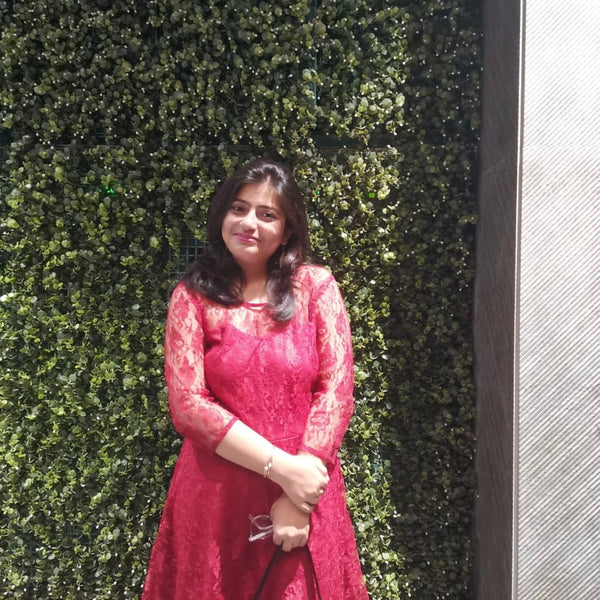Read time : min
Meet Dr. Anwesha Mukherjee
Anwesha Mukherjee was born in a family of Vaidyas. Imbibing the values of harmony and living in sync with nature, she dreamt of being a healer. But there was one challenge: there weren’t any female Vaidyas in her family that she could look up to. Determined to make her dream come true, Anwesha decided to take it as a challenge and carry forward her family’s legacy of being renowned Vaidyas’.
“My ancestors were prolific healers of their time in the Hooghly district of West Bengal. They documented all their work and transformed a store room into a proper clinic by taking inspiration from a British doctor's clinic,” says Anwesha.
Though her father didn’t practice Ayurvedic medicine, Anwesha’s uncle was an adult figure she looked up to to fulfil her dream of becoming an Ayurveda doctor. Upon graduation, she was looking forward to assisting him in the clinic but due to his untimely passing, she couldn’t go on with her plan. At present, Anwesha is trying to set up her practice and re-establish her family’s name in the Ayurveda world. She is also working on reviving her family’s Ayurveda Pharmacy which had shut operations over 35 years ago.
Also read: 5 Interesting Facts about Sage Bharadwaja

And while her journey has her set of challenges and setbacks, the two people that continue to inspire Anwesha are her mother and grandma. “I’ve been my grandma sincerely follow Ayurvedic Dinacharya and Ritucharya. She also taught me about important concepts like Ritusandhi,” she adds. Anwesha’s parents have been her biggest motivators and encouraged her to further her goals through her practice.
Circling back to the roots
“During my schooling, following Ayurvedic rituals was part of my daily routine. But then I was admitted to BAMS and had to move to the university hostel and keeping up with the Dinacharya became a huge challenge for me. Staying up late at night became a common norm. It was a hassle to maintain a healthy diet too since I’d often end up skipping breakfast. Clearly, exercise and Yoga were beyond imagination!”
It wasn’t until the third year of her degree that Anwesha started experiencing the cumulative effects of these unhealthy habits. “I didn’t get my period for over 2 months. After consulting my professors, I learned that I had PCOS. That changed my life.”
This newfound awareness prompted Anwesha to make significant lifestyle changes and circle back to her original routine - the Ayurvedic Dinacharya. She started cooking her own meals, which mostly comprised Satvik foods and good fats like cow ghee. She also incorporated movement into her day-to-day activity. Within a year of following this regimen, Anwesha was successfully able to manage her PCOS symptoms. Her menstrual cycle was back to normal, she had less hairfall and managed to maintain a healthy weight.
Also read: Are you a Shatavari Woman?
A typical day

“I wake up by 6 AM and complete my morning rituals which involve worship and drinking warm water. This is followed by my personal study of the Samhitas till 10 AM. I then eat a light breakfast and leave for my clinic. Since I don’t get take to exercise, I walk to the metro station as well as my clinic which is usually about 10KMs of daily walking. After my clinic hours are over, I begin with my online consultations. I usually have a light and early dinner, watch a movie or a show or journal and spend time on social media and then retire to bed.”
Dr. Anwesha suggests the following golden rules for having optimal health:
- Early to bed and early to rise - follow the circadian rhythm
- Practice Abyanga - self-massage with herb-infused oil
- Include ghee and warm water in your regular diet
- Drink water only when you are thirsty
- Do not skip lunch no matter how busy you are
- Eat one fruit a day
- Expose yourself to open-air post dinner
Biggest accomplishment
Having consulted hundreds of patients, Dr. Anwesha recalls this story that she believes to be one of her achievements she is proud of.

“I was asked to visit a patient by a senior MBBS doctor at the hospital. The patient had a history of CVA (cerebrovascular accident) and was bedridden for the last 3 months,” explains Dr. Anwesha. The patient got gotten bedsores which were complicated further due to his uncontrolled BP and blood sugar. Everyone in the hospital including the family members all hope for the patient’s survival. But within one month of Dr. Anwesha’s Panchakarma treatment and regular dosage of Ayurveda medicine, his bedsores began healing and she was able to save the patient. “This is one of the biggest accomplishments of my life that I am proud of!”
Also read: All you need to know about Panchakarma
Message to the readers
Dr. Anwesha believes that awareness regarding Ayurveda and Yoga must be incorporated since a young age. Simple Yoga asanas, Ayurvedic Dinacharya, Sadvritta, Achar Rasayana must be taught in schools from primary levels. Weekly workshops in schools and colleges can also help enhance the existing understanding of health and self-care through Yoga and Ayurveda.
Her message to the readers is:
“It's very easy to start but very hard to maintain. So, if you are following the Ayurveda lifestyle, try to follow it as much as you can. Because your body takes time to adapt to any changes and disruption in the routine can make your body vulnerable. We are nothing without our health. So focus on it first and everything else can come after!”
From Amrutam’s list of holistic recipes, Dr. Anwesha is keen to try our bestselling Nari Sondarya Malt and Amrutam Orthokey Gold Capsules since she sincerely believes that strong bones can give you a strong attitude!
We are beyond grateful to have Dr. Anwesha Mukherji as part of our #AmrutamFamily!
Check out More on Rediscovering Ayurveda











